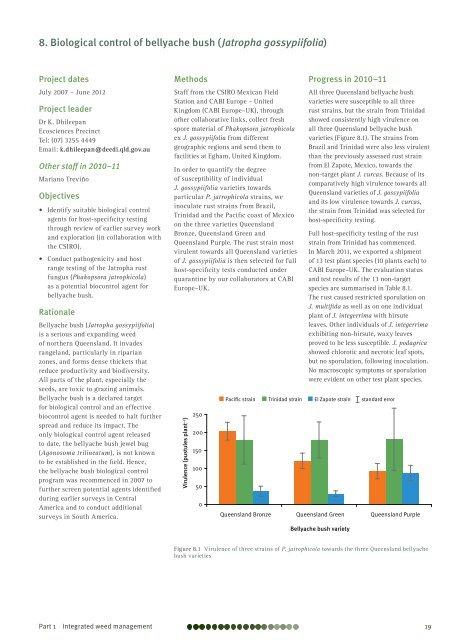Technical highlights - Department of Primary Industries ...
Technical highlights - Department of Primary Industries ...
Technical highlights - Department of Primary Industries ...
You also want an ePaper? Increase the reach of your titles
YUMPU automatically turns print PDFs into web optimized ePapers that Google loves.
8. Biological control <strong>of</strong> bellyache bush (Jatropha gossypiifolia)<br />
Project dates<br />
July 2007 – June 2012<br />
Project leader<br />
Dr K. Dhileepan<br />
Ecosciences Precinct<br />
Tel: (07) 3255 4449<br />
Email: k.dhileepan@deedi.qld.gov.au<br />
Other staff in 2010–11<br />
Mariano Treviño<br />
Objectives<br />
• Identify suitable biological control<br />
agents for host-specificity testing<br />
through review <strong>of</strong> earlier survey work<br />
and exploration (in collaboration with<br />
the CSIRO).<br />
• Conduct pathogenicity and host<br />
range testing <strong>of</strong> the Jatropha rust<br />
fungus (Phakopsora jatrophicola)<br />
as a potential biocontrol agent for<br />
bellyache bush.<br />
Rationale<br />
Bellyache bush (Jatropha gossypiifolia)<br />
is a serious and expanding weed<br />
<strong>of</strong> northern Queensland. It invades<br />
rangeland, particularly in riparian<br />
zones, and forms dense thickets that<br />
reduce productivity and biodiversity.<br />
All parts <strong>of</strong> the plant, especially the<br />
seeds, are toxic to grazing animals.<br />
Bellyache bush is a declared target<br />
for biological control and an effective<br />
biocontrol agent is needed to halt further<br />
spread and reduce its impact. The<br />
only biological control agent released<br />
to date, the bellyache bush jewel bug<br />
(Agonosoma trilineatum), is not known<br />
to be established in the field. Hence,<br />
the bellyache bush biological control<br />
program was recommenced in 2007 to<br />
further screen potential agents identified<br />
during earlier surveys in Central<br />
America and to conduct additional<br />
surveys in South America.<br />
Methods<br />
Staff from the CSIRO Mexican Field<br />
Station and CABI Europe – United<br />
Kingdom (CABI Europe–UK), through<br />
other collaborative links, collect fresh<br />
spore material <strong>of</strong> Phakopsora jatrophicola<br />
ex J. gossypiifolia from different<br />
geographic regions and send them to<br />
facilities at Egham, United Kingdom.<br />
In order to quantify the degree<br />
<strong>of</strong> susceptibility <strong>of</strong> individual<br />
J. gossypiifolia varieties towards<br />
particular P. jatrophicola strains, we<br />
inoculate rust strains from Brazil,<br />
Trinidad and the Pacific coast <strong>of</strong> Mexico<br />
on the three varieties Queensland<br />
Bronze, Queensland Green and<br />
Queensland Purple. The rust strain most<br />
virulent towards all Queensland varieties<br />
<strong>of</strong> J. gossypiifolia is then selected for full<br />
host-specificity tests conducted under<br />
quarantine by our collaborators at CABI<br />
Europe–UK.<br />
Virulence (pustules plant –1 )<br />
-<br />
250<br />
200<br />
150<br />
100<br />
Virulence<br />
50<br />
(pustules plant<br />
0<br />
Progress in 2010–11<br />
All three Queensland bellyache bush<br />
varieties were susceptible to all three<br />
rust strains, but the strain from Trinidad<br />
showed consistently high virulence on<br />
all three Queensland bellyache bush<br />
varieties (Figure 8.1). The strains from<br />
Brazil and Trinidad were also less virulent<br />
than the previously assessed rust strain<br />
from El Zapote, Mexico, towards the<br />
non-target plant J. curcas. Because <strong>of</strong> its<br />
comparatively high virulence towards all<br />
Queensland varieties <strong>of</strong> J. gossypiifolia<br />
and its low virulence towards J. curcas,<br />
the strain from Trinidad was selected for<br />
host-specificity testing.<br />
Full host-specificity testing <strong>of</strong> the rust<br />
strain from Trinidad has commenced.<br />
In March 2011, we exported a shipment<br />
<strong>of</strong> 13 test plant species (10 plants each) to<br />
CABI Europe–UK. The evaluation status<br />
and test results <strong>of</strong> the 13 non-target<br />
species are summarised in Table 8.1.<br />
The rust caused restricted sporulation on<br />
J. multifida as well as on one individual<br />
plant <strong>of</strong> J. integerrima with hirsute<br />
leaves. Other individuals <strong>of</strong> J. integerrima<br />
exhibiting non-hirsute, waxy leaves<br />
proved to be less susceptible. J. podagrica<br />
showed chlorotic and necrotic leaf spots,<br />
but no sporulation, following inoculation.<br />
No macroscopic symptoms or sporulation<br />
were evident on other test plant species.<br />
Pacific strain Trinidad strain El Zapote strain standard error<br />
Queensland Bronze Queensland Green Queensland Purple<br />
Bellyache bush variety<br />
Figure 8.1 Virulence <strong>of</strong> three strains <strong>of</strong> P. jatrophicola towards the three Queensland bellyache<br />
bush varieties<br />
Part 1 Integrated weed management 19

















